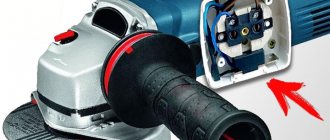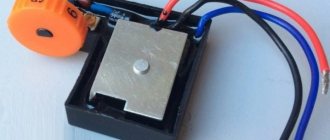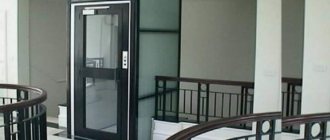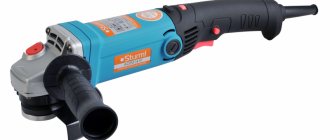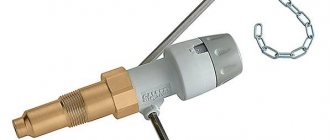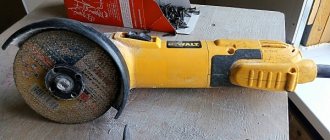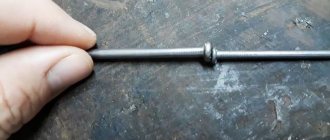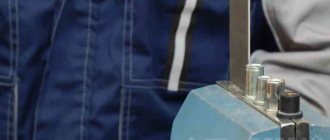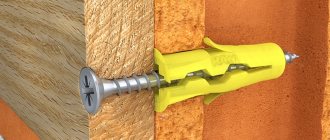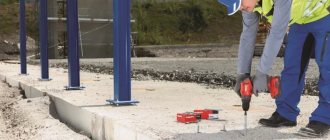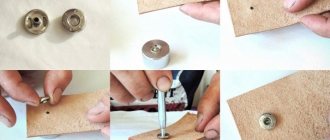Angle grinder (grinder) MAKITA GA4530 without soft start. Photo 220Volt
When buying a cheap angle grinder, it will probably not have a soft start option . During startup, especially with a powerful angle grinder, you can feel all the “delights” of the jerk that the grinder produces when turned on. If you have a soft starter, the power tool will begin to do its job in a comfortable environment for the user . Undoubtedly, an angle grinder with this option costs more. However, it is possible to install a soft starter on the angle grinder yourself. This will solve the issues of saving money and will facilitate further operation - a device made by yourself is easier to repair if it fails.
Device
In grinders without a soft start, the windings of the commutator motor are immediately supplied with a 220 V mains voltage , and to bring it into working condition an increased starting current is required. The soft starter ensures a gradual increase in voltage and, accordingly, the current during startup also does not increase abruptly.
This starting mode can be achieved using a special electronic circuit . Its main component is a semiconductor chip , which controls another, more powerful semiconductor device, a triac, which supplies power to the electric drive of the angle grinder. The thyristors of the microcircuit operate with a delay in the supply voltage until the circuit capacitor is fully charged. The principle of operation of the microcircuit is successfully combined with ensuring a smooth start of angle grinders.
Microcircuits k1182, LM358
The most famous microcircuit for the K1182 soft starter. This microcircuit was created back in Soviet times and now it is not so easy to find. There are other more affordable chips, for example, LM358. Many modern angle grinders use the LM358 chip in the factory version of the device.
LM358 chip
Duty cycle and its characteristics
The full operating cycle of any electric drive can be divided into four technological stages:
- start, during which the shaft/armature rotation speed increases from zero to the required value;
- working, during which the motor operates at a constant voltage at the terminals of the rotor circuit and the excitation circuit;
- regulation when the internal circuits (anchor block or excitation) are influenced in order to change the shaft speed;
- stop, characterized by a decrease in speed to zero.
According to the given cycle structure, starting, operating, control and braking characteristics are distinguished. The starting stage is considered in relation to the parameters of starting torque, current, process duration, cost of additional devices and energy costs. At the same time, they ensure the smoothest possible start of the commutator motor. The main characteristics of the mechanical energy of an electric motor are torque and rotation speed.
The operating period is estimated by a set of dependencies, including the shaft speed, current parameters of the drive in the rotor electrical circuit, useful torque, efficiency of the useful power of the CD at a constant supply voltage and current in the excitation winding. Regulatory characteristics are determined by the limits, steps and method of changing speed parameters. The ability to smoothly regulate the speed of an electric machine over a wide range is one of the most valuable qualities of this category of electrical equipment. The braking mode of the rotor mechanism when the power is turned off occurs due to friction forces. To speed up the stopping of powerful electric machines, one of the braking methods is implemented by creating a braking torque directed against the rotation of the armature.
Operating principle
The soft start device in a factory-made angle grinder is located inside the angle grinder body and is connected by contacts to the power button and the stator windings of the electric drive. It takes a certain time for the angle grinder to reach its nominal mode, and the electromagnetic field created by the uniformly increasing current and voltage through the stator windings causes the armature of the angle grinder drive to smoothly gain speed.
For grinders where the manufacturer does not provide such a device, usually in very rare cases it is possible to hide it under the body of the grinder. Most often it is performed in the form of a separate block, arranged in a break in the power cable circuit. However, this does not change the principle of operation.
Main structural elements
A commutator electric machine is equipment in which the shaft angular position sensor and the current load switch in electrical circuits are the same device, called a brush-commutator unit. The general structural diagram of any commutator motor (CM) is similar to other types of electric motors. The stationary part is called the stator/inductor/inductor wheel, the moving/rotating part is called the rotor/armature. The drive structure is shown in the figure:
The stator contains a frame (supporting part) and main poles. The support structure serves to fix the poles and shields of the ball bearings. It serves as a component of the magnetic circuit, since it is the link through which the magnetic flux of the drive equipment is closed. The supporting part is made of metal, is extremely durable and magnetically permeable. It has supports in the lower part and special holes around the circumference for securing the cores of the main poles. As a rule, this is a solid element. A detachable design is available for variants with large dimensions. This makes transportation, assembly, maintenance and repair easier.
The main poles that generate the magnetic flux contain a core and a pole coil with a wound wire. On the side of the rotor assembly, the core has a special tip that distributes magnetic induction in the internal space of the CD. The cores are made of sheet steel. In low-power 220V electric motors, frameless poles are formed, with direct winding of the electrical conductor onto a pre-insulated core. In electric machines with a power of more than one kilowatt, the coil is a frame with a wire wound on it.
The structural diagram of the anchor mechanism includes the following elements:
- shaft;
- core with electric winding;
- collector node.
The core is made in the form of a laminated product, assembled from steel plates insulated with varnish, which are collected in a single package, baked and pressed onto the shaft. This solution makes it possible to reduce eddy current flows formed during rotation in magnetic space. A winding made of copper wire is placed in the outer grooves of the anchor assembly.
The collector device is one of the key and complex structural units of the compressor. Consists of copper trapezoidal plates assembled into a cylindrical shape. Depending on the method of fastening the metal elements, the collectors can be with steel cone-shaped washers or on plastic (for low-power electric machines). To ensure electrical contact with the commutator unit, brushes with a flexible cable are placed in special brush holders, which connects the brushes to the electrical circuit. For stable operation of the electric drive, constant reliable contact is ensured between the brush element and the commutator.
Disadvantages of angle grinders without soft start
Cordless angle grinder Metabo W 18 LTX 125 602174850 with soft start. Photo VseInstruments.ru
In addition to providing comfortable working conditions for the user, the angle grinder with soft start has a number of other advantages.
- The absence of a large starting current during the soft start of the angle grinder , which is several times higher than the nominal value of this parameter during operation, increases the reliability of the electrical part of the power tool. In this case, the winding wires do not experience overloads and do not crack, the commutator lamellas and brushes are not subject to wear from increased sparking, and processes that worsen the connection do not occur at the contact points.
- During a uniform increase in the speed to the nominal value, the angle grinder with a soft start does not experience increased dynamic loads that arise in its absence. An instantaneous acceleration of 6000 rpm or more does not leave its mark on the gear transmission and bearing units . They fail faster, so angle grinders without such a device are more often repaired.
Models for angle grinder 600 W
For 600 W angle grinders, starters with contact triacs are used, in which the overload does not exceed 10 A. It is also worth noting that there are many devices with plates. They are distinguished by their security and are not afraid of elevated temperatures. The minimum frequency for 600 W angle grinders is 30 Hz. In this case, the resistance depends on the installed triode. If it is used of the linear type, then the above parameter does not exceed 50 Ohms.
Read also: 18 volt charger for diold screwdriver
If we talk about duplex triodes, then the resistance at high speeds can reach up to 80 Ohms. Very rarely, models have stabilizers that operate from comparators. Most often they are attached directly to the modules. Some modifications are made with wired transistors. Their minimum frequency starts from 5 Hz. They are afraid of overloads, but are able to maintain high speeds at a voltage of 220 V.
How to make a starter unit for a power tool
There are quite a lot of options for independently equipping an angle grinder with a soft start device. Some of them are presented in the author's videos.
Starter unit based on LM358 chip
In the following video, the author shares his experience of independently manufacturing a soft-starter board according to a diagram taken from the Internet, based on the LM358 chip . The author made the housing for the board from a shampoo box, which speaks of the rich imagination of amateur craftsmen. The author did not just blindly copy the circuit from the Internet, but modified it by replacing the characteristics of some of its elements : transistors, diodes, resistors. The radiator for cooling semiconductor devices is taken from a tape recorder. In order to be able to place the soft start unit inside the body of the angle grinder, and not as in the case of the proposed option, a smaller board was developed.
Technology of work on the manufacture of the starting unit
The author of the following video describes in detail the work methods, components used and auxiliary technological materials for the manufacture of a soft starter. the k1182 microcircuit is taken as the basic element . The technology is not designed for use as the basis of a printed circuit board; the author calls such an assembly “surround mounting” technology. In this type of work, in addition to soldering, individual elements are fastened using fasteners, for example, this is how a triac is attached to a heat sink. The ready-made launcher is not universal for all angle grinders. On two angle grinders taken separately by the author, they reached the operating mode in significantly different periods of time.
One of the layout options for a homemade launch unit
As the initial option, the author of the following video chose a well-known assembly with the LM358 chip . Since the assembled starting unit did not fit inside the body of the angle grinder, the author “packed” only a triac with a radiator inside, due to good cooling conditions from the angle grinder’s fan wheel. The rest of the block, together with the microcircuit, was secured to the body of the angle grinder.
Using an iron as an additional load to reduce the speed of an angle grinder
This method does not specifically relate to the topic of soft start of an angle grinder. However, to understand the principle of operation of an electronic device, a dimmer , which is used to adjust the power (or number of revolutions) of an angle grinder, is quite acceptable. In the next video, the iron takes a certain power from the angle grinder, thereby reducing its speed.
The typical starter circuit diagram should be modified for each individual power tool
The author of the following video tells how he equipped his household grinder with a soft start device to increase its service life.
Important: the circuit may work perfectly for adjusting the brightness of the lamp, but for the necessary functioning of the angle grinder, upon startup, be unable to perform the task. To operate effectively, it must be “customized ,” namely, select the required resistor values, capacitor values, and possibly change the characteristics of semiconductor devices.
How to install a standard dimmer in an angle grinder to adjust speed
In the next video, the author modified the power button (made it spring-loaded) in order to use the capabilities of a purchased dimmer to adjust the speed of the angle grinder. After turning on the angle grinder, moving the button sets the required speed mode. The dimmer fixes this mode and when turned on again, it is set.
How to connect, installation
For users of grinders who do not have electrical installation skills, you can purchase a separately sold soft start unit. You just need to install it correctly. There are two options for placing the starting device - inside the body of the angle grinder and, if not possible, outside.
In the next video, the author placed one of the purchased blocks inside it with the help of a slight modification of the angle grinder body. The two wires of the starting unit are connected according to the following diagram: one wire to the switch contact, the other to the stator winding of the electric drive.
In another video, the author also managed to place the purchased block inside the grinder. However, he chose a different connection scheme - to break the network. In this case, it is not important to consider where to connect the “zero” and where the “phase”.
How to check
At home, before assembling an angle grinder with a soft starter, it’s a good idea to check it for an open circuit. The following video tests a three-pin device. Usually there is a connection diagram . There are two network wires here, one goes to the electric drive. If you assemble a circuit with an indicator light and include a starter in it, then you can determine the break in it by the indicator light coming on/not coming on .
Soft start methods
The soft start of a commutator motor discussed above refers to the classic rheostat method, suitable for both direct and alternating current. Its negative aspects are the loss of a significant part of the power for heating the rheostat resistance and the bulkiness of the device. Therefore, this method is practically and economically justified only for starting the electric drive, but not for regulating the operating speed parameters. In general, starting drive devices and power tools can be done using other methods using:
- transformers;
- semiconductor switches.
The use of transformers is only permissible for alternating current objects. Its advantage is increased electrical safety when working with power tools. The disadvantage of this method is its rather large size and cost, even when manufactured independently.
The use of semiconductor switches is the most modern and inexpensive way to get a smooth start. Their main feature is the absence of mechanical contacts and high switching speed. Power switches are capable of handling high current loads and voltages. They practically do not heat up, consume minimal electricity and are the best option for electric motors of modern electric tools. There are three types of power switches:
- thyristors and triacs;
- MOSFET field effect transistors with isolated MOS gate;
- IGBT transistors.
Thyristors and triacs are designed to regulate power in circuits with variable current values. Powerful MOSFET field-effect transistors control the parameters of the mains current by changing the width of the opening pulses. This type of device finds its application in DC power supply. For high power tools, IGBT bipolar transistors with an insulated gate are used.
